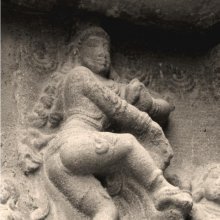Bhujanga, Bhujaṅga, Bhujamga: 16 definitions
Introduction:
Bhujanga means something in Buddhism, Pali, Hinduism, Sanskrit, Jainism, Prakrit, the history of ancient India, Marathi. If you want to know the exact meaning, history, etymology or English translation of this term then check out the descriptions on this page. Add your comment or reference to a book if you want to contribute to this summary article.
Images (photo gallery)
In Hinduism
Purana and Itihasa (epic history)
Source: archive.org: Puranic EncyclopediaBhujaṅga (भुजङ्ग).—A son of Kadrū by Kaśyapa prajāpati.
Source: Cologne Digital Sanskrit Dictionaries: The Purana IndexBhujaṅga (भुजङ्ग).—Served as a rope for Manu to tie the divine boat to the horn of the fish;1 Indra took the guise of, to disturb the tapas of Vajrāngī;2 born to ward off poison.3

The Purana (पुराण, purāṇas) refers to Sanskrit literature preserving ancient India’s vast cultural history, including historical legends, religious ceremonies, various arts and sciences. The eighteen mahapuranas total over 400,000 shlokas (metrical couplets) and date to at least several centuries BCE.
Jyotisha (astronomy and astrology)
Source: Wisdom Library: Brihat Samhita by VarahamihiraBhujaṅga (भुजङ्ग) refers to a “serpent” and is used to describe Rāhu, according to the Bṛhatsaṃhitā (chapter 5), an encyclopedic Sanskrit work written by Varāhamihira mainly focusing on the science of ancient Indian astronomy astronomy (Jyotiṣa).—Accordingly, “Some say that Rāhu, the asura, though his head was cut, dies not but lives in the shape of a planet having tasted of ambrosia. That he has a disc like the sun and moon and as that disc is black it is invisible when in the sky except on the occasion of eclipses in virtue of a boon from Brahmā. Others say that he resembles a serpent [i.e., bhujaṅga] in shape with his head severed from his tail; a few that he is bodiless, that he is mere darkness and that he is the son of Siṃhikā. [...]”.

Jyotisha (ज्योतिष, jyotiṣa or jyotish) refers to ‘astronomy’ or “Vedic astrology” and represents the fifth of the six Vedangas (additional sciences to be studied along with the Vedas). Jyotisha concerns itself with the study and prediction of the movements of celestial bodies, in order to calculate the auspicious time for rituals and ceremonies.
Shaktism (Shakta philosophy)
Source: Google Books: ManthanabhairavatantramBhujaṅga (भुजङ्ग) refers to one of the nine Bhairava associated with the nine energies of Navātman, according to the Manthānabhairavatantra, a vast sprawling work that belongs to a corpus of Tantric texts concerned with the worship of the goddess Kubjikā.—[Note: this passage is drawn from the Gurukramasūtra]—Another way in which the nine energies of Navātman may be understood are as nine aspects of the Command that generates the Bhairavas corresponding to its nine letters. [...] In this case Navātman is SHKṢMLVRYŪ(Ṃ): [...] The one called Bhujaṅga (Ra) is (generated by) Saṃkarṣaṇī [...] (This) is the excellent teacher within the tradition. He who knows the teacher here is the delight of Kula.

Shakta (शाक्त, śākta) or Shaktism (śāktism) represents a tradition of Hinduism where the Goddess (Devi) is revered and worshipped. Shakta literature includes a range of scriptures, including various Agamas and Tantras, although its roots may be traced back to the Vedas.
Ayurveda (science of life)
Toxicology (Study and Treatment of poison)
Source: Shodhganga: Kasyapa Samhita—Text on Visha ChikitsaBhujaṅga (भुजङ्ग) is a synonym of Sarpa (“snake”), according to the Amarakośa.—The Sanatkumāra Saṃhitā (III.36cd-37ab) states that snakes are of two kinds, Nāgas and Sarpas. While the former can take any form they desire, the latter are those which glide. The Amarakośa (verses I.10.3-6) gives 33 synonyms for snake [viz. Bhujaṅga]. Snakes are said to reside in Nāgaloka which is located in the endless bowels of the earth with countless palaces, houses and towers, it is also known as pātālaloka.

Āyurveda (आयुर्वेद, ayurveda) is a branch of Indian science dealing with medicine, herbalism, taxology, anatomy, surgery, alchemy and related topics. Traditional practice of Āyurveda in ancient India dates back to at least the first millenium BC. Literature is commonly written in Sanskrit using various poetic metres.
In Buddhism
Tibetan Buddhism (Vajrayana or tantric Buddhism)
Source: OSU Press: Cakrasamvara SamadhiBhujaṅga (भुजङ्ग) refers to a “snake”, according to the Cakrasaṃvara Samādhi [i.e., Cakrasamvara Meditation] ritual often performed in combination with the Cakrasaṃvara Samādhi, which refers to the primary pūjā and sādhanā practice of Newah Mahāyāna-Vajrayāna Buddhists in Nepal.—Accordingly, “Oṃ eat eat to the hanging garland of greasy bloody entrails, to Surābhakṣī Hūṃ Phaṭ Svāhā! Oṃ seize seize the snake (bhujaṅga) or serpent come forth from the seven underworlds Hūṃ Phaṭ Svāhā”.

Tibetan Buddhism includes schools such as Nyingma, Kadampa, Kagyu and Gelug. Their primary canon of literature is divided in two broad categories: The Kangyur, which consists of Buddha’s words, and the Tengyur, which includes commentaries from various sources. Esotericism and tantra techniques (vajrayāna) are collected indepently.
In Jainism
General definition (in Jainism)
Source: The University of Sydney: A study of the Twelve ReflectionsBhujaṅga (भुजङ्ग) refers to a “snake”, according to the 11th century Jñānārṇava, a treatise on Jain Yoga in roughly 2200 Sanskrit verses composed by Śubhacandra.—Accordingly, “The pleasures that are cherished, like the poison of a snake (bhujaṅga—bhogā bhujaṅgabhogābhāḥ), are the thieves of life immediately and they are produced in the cycle of rebirth by the 30 gods”.
Synonyms: Nāga, Bhogin, Vyāla, Bhujaga.

Jainism is an Indian religion of Dharma whose doctrine revolves around harmlessness (ahimsa) towards every living being. The two major branches (Digambara and Svetambara) of Jainism stimulate self-control (or, shramana, ‘self-reliance’) and spiritual development through a path of peace for the soul to progess to the ultimate goal.
India history and geography
Source: Cologne Digital Sanskrit Dictionaries: Indian Epigraphical GlossaryBhujaṅga.—(IA 20), an ogre. The word bhujaṅga was adopted in Javanese in the sense of a ‘pupil, disciple, scholar; a philologist, poet, literary councillor; an officially appointed professional usually residing at or near the court’. It has been suggested on this basis that Bhavadeva-bhaṭṭa's title Bālavalabhī-bhujaṅga may really mean ‘the pupil of the Bālavalabhī school’. See IHQ, Vol. XXVII, pp. 80-82. Note: bhujaṅga is defined in the “Indian epigraphical glossary” as it can be found on ancient inscriptions commonly written in Sanskrit, Prakrit or Dravidian languages.

The history of India traces the identification of countries, villages, towns and other regions of India, as well as mythology, zoology, royal dynasties, rulers, tribes, local festivities and traditions and regional languages. Ancient India enjoyed religious freedom and encourages the path of Dharma, a concept common to Buddhism, Hinduism, and Jainism.
Languages of India and abroad
Pali-English dictionary
Source: BuddhaSasana: Concise Pali-English Dictionarybhujaṅga : (m.) a snake.

Pali is the language of the Tipiṭaka, which is the sacred canon of Theravāda Buddhism and contains much of the Buddha’s speech. Closeley related to Sanskrit, both languages are used interchangeably between religions.
Marathi-English dictionary
Source: DDSA: The Molesworth Marathi and English Dictionarybhujaṅga (भुजंग).—m (S) A snake. Applied popularly only to the nāga or Cobra de capello. 2 A term for a wencher or for one who keeps a mistress. 3 A term of praise for any competent, capable, powerful, or clever person. 4 Applied also to a fiery or fierce person.
Source: DDSA: The Aryabhusan school dictionary, Marathi-Englishbhujaṅga (भुजंग).—m A snake; applied to a fiery person.
Marathi is an Indo-European language having over 70 million native speakers people in (predominantly) Maharashtra India. Marathi, like many other Indo-Aryan languages, evolved from early forms of Prakrit, which itself is a subset of Sanskrit, one of the most ancient languages of the world.
Sanskrit dictionary
Source: DDSA: The practical Sanskrit-English dictionaryBhujaṅga (भुजङ्ग).—[bhujaḥ san gacchati gam-khac mum ḍicca]
1) A serpent, snake; भुजङ्गमपि कोपितं शिरसि पुष्पवद्धारयेत् (bhujaṅgamapi kopitaṃ śirasi puṣpavaddhārayet) Bhartṛhari 2.4.
2) A paramour, gallant; अभूमिरेषा भुजङ्गभङ्गिभाषितानाम् (abhūmireṣā bhujaṅgabhaṅgibhāṣitānām) K.196.
3) A husband or lord in general.
4) A catamite.
5) The dissolute friend of a king.
6) The constellation आश्लेषा (āśleṣā).
7) The number 'eight'.
-gī A serpent nymph.
Derivable forms: bhujaṅgaḥ (भुजङ्गः).
Source: Cologne Digital Sanskrit Dictionaries: Shabda-Sagara Sanskrit-English DictionaryBhujaṅga (भुजङ्ग).—m.
(-ṅgaḥ) 1. A snake. 2. A catamite, a lecher. f. (-ṅgī) A female snake. E. bhuj a curve, gam to go, khac aff.; also bhujaṅgama .
Source: Cologne Digital Sanskrit Dictionaries: Yates Sanskrit-English DictionaryBhujaṅga (भुजङ्ग):—[bhuja-ṅga] (ṅgaḥ) 1. m. A snake; a catamite, a lecher. f. (ṅgī).
Source: DDSA: Paia-sadda-mahannavo; a comprehensive Prakrit Hindi dictionary (S)Bhujaṃga (भुजंग) in the Sanskrit language is related to the Prakrit word: Bhuaṃga.
Sanskrit, also spelled संस्कृतम् (saṃskṛtam), is an ancient language of India commonly seen as the grandmother of the Indo-European language family (even English!). Closely allied with Prakrit and Pali, Sanskrit is more exhaustive in both grammar and terms and has the most extensive collection of literature in the world, greatly surpassing its sister-languages Greek and Latin.
Kannada-English dictionary
Source: Alar: Kannada-English corpusBhujaṃga (ಭುಜಂಗ):—
1) [noun] = ಭುಜಗ - [bhujaga -] 1 & 2.
2) [noun] one’s master; lord; owner.
3) [noun] a learned man; a scholar.
4) [noun] a man who is observing religious austerities rigorously.
Kannada is a Dravidian language (as opposed to the Indo-European language family) mainly spoken in the southwestern region of India.
See also (Relevant definitions)
Partial matches: Nga, Bhuja, Na.
Starts with (+29): Bhujamgabhogashrite, Bhujamgaloka, Bhujamganilaya, Bhujamgashayana, Bhujamgavali, Bhujamgavine, Bhujamgavritti, Bhujangabha, Bhujangabhoga, Bhujangabhojin, Bhujangabhuj, Bhujangabhuk, Bhujangadhipa, Bhujangadhipati, Bhujangadvara, Bhujangaghatini, Bhujangahan, Bhujangajihva, Bhujangakanya, Bhujangakhya.
Ends with: Bhavadeva vallabhibhujanga, Bhavanibhujanga, Candabhujanga, Chandabhujanga, Devibhujanga, Ganapatibhujanga, Ganeshabhujanga, Hanumadbhujanga, Mallaribhujanga, Narasimhabhujanga, Pratibhujanga, Raja-veshya-bhujanga, Rajavesibhujanga, Ramabhujanga, Ratribhujanga, Saccidanandabhujanga, Sphotyabhujanga, Subrahmanyabhujanga, Vishabhujanga, Vishnubhujanga.
Full-text (+96): Bhujamga, Bhujangahan, Bhujamgaparnini, Bhujamgama, Vishabhujanga, Bhujangabhojin, Bhujamgesha, Bhujamgerita, Bhujangabhuj, Bhaujanga, Bhujamgabhojin, Bhujangaghatini, Bhujamgakshi, Bhujamgaprayatashtaka, Bhujamgadamani, Bhujamgaprayatastotra, Bhujamgashatru, Bhujamgastotra, Bhujamgaprayata, Bhujamgasamgata.
Relevant text
Search found 25 books and stories containing Bhujanga, Bhujaṅga, Bhuja-nga, Bhuja-ṅga, Bhujamga, Bhujaṃga; (plurals include: Bhujangas, Bhujaṅgas, ngas, ṅgas, Bhujamgas, Bhujaṃgas). You can also click to the full overview containing English textual excerpts. Below are direct links for the most relevant articles:
Bhakti-rasamrta-sindhu (by Śrīla Rūpa Gosvāmī)
Verse 2.1.383 < [Part 1 - Ecstatic Excitants (vibhāva)]
Verse 4.6.5 < [Part 5 - Dread (bhayānaka-rasa)]
Verse 2.4.124 < [Part 4 - Transient Ecstatic Disturbances (vyābhicāri-bhāva)]
Sahitya-kaumudi by Baladeva Vidyabhushana (by Gaurapada Dāsa)
Text 10.69 < [Chapter 10 - Ornaments of Meaning]
Text 11.6 < [Chapter 11 - Additional Ornaments]
Text 10.20 < [Chapter 10 - Ornaments of Meaning]
Chaitanya Bhagavata (by Bhumipati Dāsa)
Verse 1.4.76 < [Chapter 4 - Name-giving Ceremony, Childhood Pastimes, and Thieves Kidnap the Lord]
Verse 3.2.308 < [Chapter 2 - Description of the Lord’s Travel Through Bhuvaneśvara and Other Placesto Jagannātha Purī]
The Religion and Philosophy of Tevaram (Thevaram) (by M. A. Dorai Rangaswamy)
Chapter 4.3 - (a) Nataraja (the dance of Shiva) < [Volume 2 - Nampi Arurar and Mythology]
Chapter 4.3 - (b) The seven Tandava Dances of Shiva < [Volume 2 - Nampi Arurar and Mythology]
Chapter 4.6 - (m) Symbology of Fire < [Volume 2 - Nampi Arurar and Mythology]
Sushruta Samhita, Volume 6: Uttara-tantra (by Kaviraj Kunja Lal Bhishagratna)
Chapter LX - Symptoms and Treatment of demonology (Amanusha) < [Canto IV - Bhuta-vidya-tantra (psychology and psychiatry)]
The history of Andhra country (1000 AD - 1500 AD) (by Yashoda Devi)
Part 9 - Kadiyaraju (A.D. 1128) < [Chapter XV - The Nagas]
Part 34 - Mamnagandagopala (A.D. 1231-1299) < [Chapter XX - The Telugu Cholas (Chodas)]

